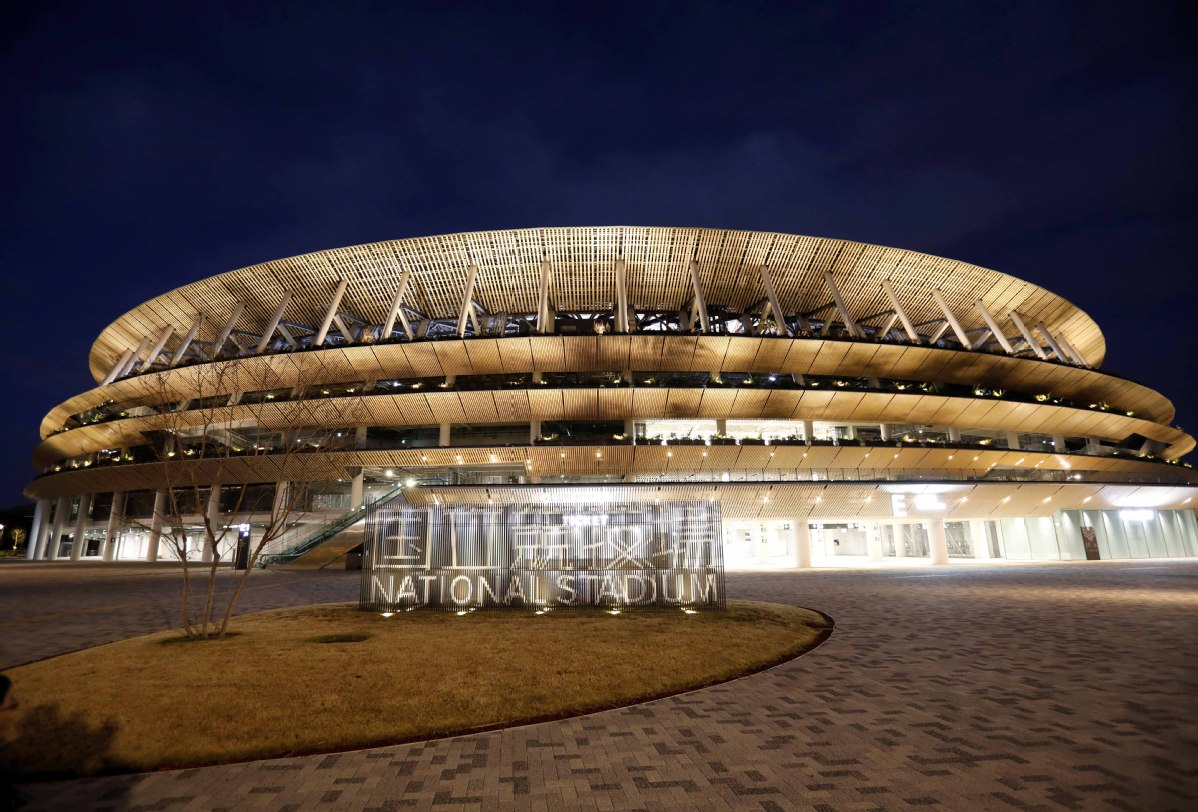"It blends with its surroundings and the natural environment," said Japanese Prime Minister Abe at a ceremony on Sunday marking the completion of the stadium that will be the venue for the opening and closing ceremonies of the 2020 Summer Olympics. The stadium will also host track and field events and some soccer games.

General view of the New National Stadium after the construction completion ceremony in Tokyo on Sunday. (Photo: China Daily)
Abe noted that the creation of Japanese architect Kengo Kuma showcased Japan's ties to nature with its use of wood latticework around the stadium's rim and roof. So did the earth-tone colors of the seats, which are randomly colored brown, gray, two shades of green and white.
At the ceremony, Tokyo Governor Yuriko Koike also pointed out, "This stadium uses a lot of trees in its structure," noting the greenery supplied by numerous flower planters, trees and shrubs.
The venue will be open to the general public on Dec 21, when it will also be visited by eight-time Olympic gold medalist runner Usain Bolt. The first real event will take place on Jan 1, 2020 with the Emperor's Cup, the championship of Japanese soccer league.
The stadium is sure to be the centerpiece of the 2020 Olympics, built at a cost of about $1.43 billion. The capacity for the Olympics will be 68,000 and can be expanded later to 80,000.
Although Tokyo is densely urban, it is also dotted with many parks and green areas. The stadium works off that theme, making sure it is functional and linked to nature.
A walkway on the stadium's fifth level, called the Grove of the Sky, is about 30 meters above street level and runs 850 meters around the entire circumference of the stadium. It's lined with benches, flowers and trees. A stroll offers a breathtaking view of Tokyo. On a clear day Mount Fuji is visible to the west.
Makoto Sato, a spokesman for the Japan Sport Council, the governmental body that built the venue, said the walkway will be open to the public on days when there are no events following the Olympics.
"We have tried to emphasize all four seasons and people can use it around the year and enjoy it," he said.
The stadium seating rises in a steep gradient from the field level and the nine-lane track, getting steeper the higher it goes. The colors of the seats also get lighter the higher up one ascends. The darkest brown seats are near the bottom-the earth-and green, gray and white ones predominate near the top.
"Because of the gradient, it creates an atmosphere where people can feel close," said Takeo Takahashi, a Japan Sport Council spokesman.
The 1964 Olympics in Tokyo left behind several architectural jewels, the most famous of which is Kenzo Tange's Yoyogi National Stadium. It was the swimming venue in 1964-US swimmer Don Schollander won four gold medals there. It will host handball competitions next year as well as the Paralympics' badminton and wheelchair rugby games.
The new stadium also features items from the old national stadium, which was razed in 2015. The most prominent are two mosaictile murals featuring the Greek goddess Nike and Nomino Sukune, a legendary sumo wrestler. They are located at the Aoyama Gate entrance to the new stadium.
Governor Koike noted on Sunday that the Olympics open in just over seven months: July 24, 2020.
"I can already envision the scene where the athletes are sprinting on this field and spectators are cheering for them in this stadium," she said.


